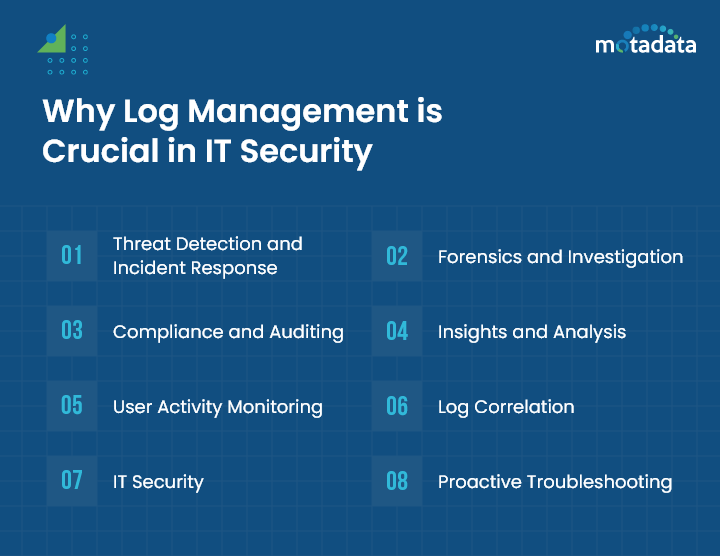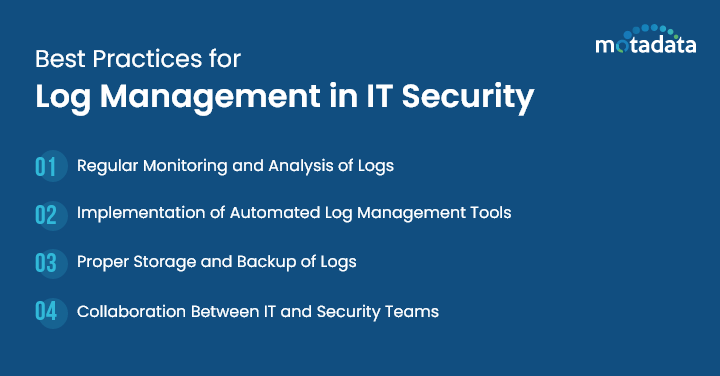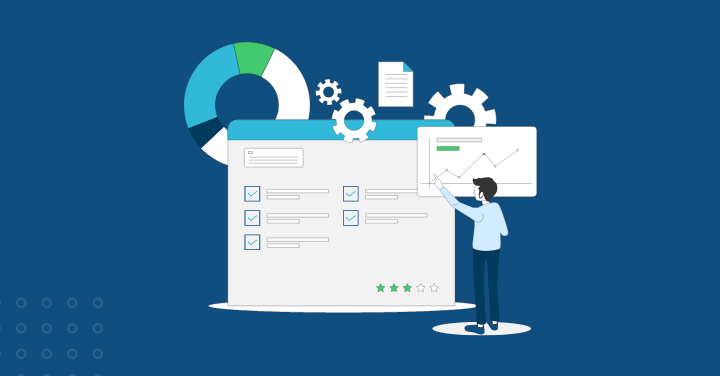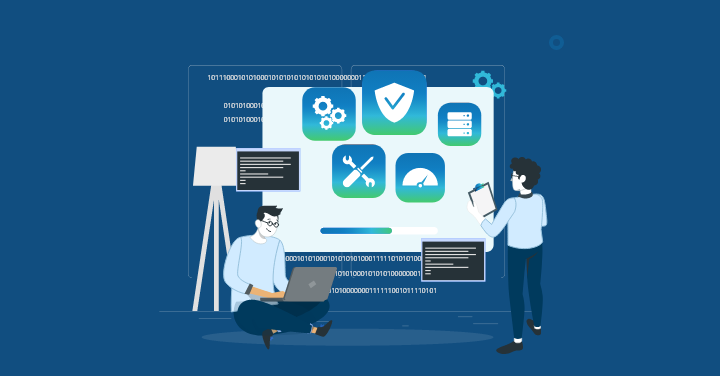Around 70% of companies experienced cyberattacks in the past year.
With this increase in cyberattacks, the importance of log management in IT security has also increased over the years.
That’s the reason why small and enterprise businesses have started to invest in log management tools to protect their businesses from cybersecurity breaches.
If your business is also struggling to fight against cybercrimes, it is time for you to incorporate a new plan of action that will offer better visibility into all the business operations and activities.
Log Management is one such security practice that most network and system administrators use to collect, process, and analyze data for a better understanding of network performance.
These logs provide a quick update on the system errors, access attempts, and other events and activities.
In this blog, we will discuss the importance and best practices for log management in IT security in detail.
Further, we will help figure out how log management can safeguard business assets and prevent breaches.
Why Log Management is Crucial in IT Security
Most businesses use intrusion detection systems and firewalls to safeguard their digital assets.
But there is another crucial step that one must not miss out on, i.e., log management.
Here are a few reasons why log management in IT security is crucial.
1. Threat Detection and Incident Response
Various activities happen on a regular basis within an organization and keeping track of it can be quite challenging.
However, if you maintain log files, tracking unusual patterns and suspicious activities becomes much easier.
In fact, with regular log file analysis, network and system administrators can discover threats at an early stage within an organization and proactively respond to them.
2. Forensics and Investigation
Another key benefit of log management is it provides valuable insights into the scope of an attack, the techniques employed by attackers, networks, applications and the systems that may have been impacted.
Additionally, it helps in getting a clear picture of the incident which further aids in enhancing security protocols and preventing breaches in the future.
3. Compliance and Auditing
Adherence to regulatory frameworks like HIPAA, GDPR, and PCI DSS helps evade legal penalties and plays a key role in maintaining customer trust.
To achieve compliance, log management is essential. With log management, organizations can demonstrate their commitment to safeguarding sensitive data and ensure privacy.
4. Insights and Analysis
Log files cover not only security events but also other information, such as overall performance and health.
With all this information, organizations can gain data-driven insights and perform better analysis.
Further, this information helps in better decision-making and resource optimization.
5. User Activity Monitoring
You can even keep track of user activities and examine access patterns or behavior using log management tools.
The tool will instantly send an alert to admins on detecting any malicious activities or any unusual movement, thus preventing breaches.
6. Log Correlation
Manual analysis of logs from different sources is not as simple as it sounds.
However, if you use log management tools, you can run analysis and identify complex attack patterns.
Further, organizations can identify hidden threats and take more effective action by establishing connections between different log entries.
7. IT Security
System administrators can receive notifications about unusual activity in the system through event logs.
Any failed login attempts or altered registration values can be tracked with log management in IT security.
As a result, you will be able to deal with security problems before they become serious.
Keep in mind that outdated software leaves security gaps that hackers can exploit to get access to your network.
8. Proactive Troubleshooting
Effective log management encourages proactive troubleshooting.
You can quickly find out and address problems in your system by looking at log events.
Further, by taking proactive measures, you can minimize your downtime and deliver a seamless user experience.
How Can Log Management Improve Security Response Time?
Log Management allows organizations to analyze all the system logs in real-time which in turn helps in early threat detection.
Admins even receive instant alerts notifying them about suspicious activities and unauthorized login attempts.
Thus, enabling organizations to reduce blind spots and respond quickly to incidents.
In simple terms, Log Management:
- Streamlines the monitoring process
- Speeds up incident identification
- Cuts down on response time
- Strengthens organization’s security
4 Best Practices for Log Management in IT Security
To keep your business safe and strengthen IT security, log management best practices must be put into action.
Here are a few practices for log management that one must consider.
1. Regular Monitoring and Analysis of Logs
You can prevent your network from compromising by performing real-time event log analysis.
This practice allows system administrators to identify the attack and its impact.
Each log file provides a comprehensive picture of your network.
As a result, you can view unusual patterns or intrusion attempts and fix them before they create any negative impact.
2. Implementation of Automated Log Management Tools
By investing in an automated log management tool, admins can efficiently collect and process log data from several sources and reduce manual errors.
Additionally, you can set up instant alert options for critical events and facilitate prompt responses to incidents.
As a result, the admin team can focus more on proactive security measures and streamline other operations.
3. Proper Storage and Backup of Logs
Apart from collection and analysis practices, the log management tool provides safe storage and backup options.
To comply with retention and compliance regulations, enterprises must first set up a scalable and secure storage system.
In this way, vital data is preserved for later use and examination, and logs are kept in compliance with industry standards and organizational requirements.
Also, by incorporating the comprehensive backup strategy, organizations can recover faster in case of data loss or corruption.
4. Collaboration Between IT and Security Teams
An essential component of efficient IT security management is teamwork between the security and IT departments.
Organizations may effectively safeguard their digital infrastructure by utilizing the combined efforts of both teams.
Proper communication and collaboration can help fill in the loopholes and prevent breaches.
How Motadata Log Management Tool Can Help You?
Motadata Log Management Tool helps users collect, monitor, and visualize event and system logs from different sources and gain actionable insights.
The tool further helps eliminate the stress of indexing and storing log events by automating the process of collecting and analyzing them.
Admins can even perform real-time monitoring and customize alert systems.
Key areas where Motadata Log Management Tool helps you:
- Collect Log Data- It uses both agent-based and agent-less techniques to consolidate log data from different settings into a single dashboard to establish a single source of truth.
- Maintain Compliance – Ensure adherence to legacy log policies, audit procedures, and log retention guidelines.
- Anomaly Detection – Turn machine data into metrics that are easy to track and find patterns to detect anomalies
- Powerful Automation – Saves time by automating log parsing using pre-made templates
Have you tried Motadata Log Management Tool? Want to Sign up for a free trial and avail benefits of this cost-effective solution?
It can be a game-changer for your business as you will be able to gain actionable insights into your IT infrastructure.
If you want to know more, you can also schedule a demo or contact us.
FAQs
Log files comprise all the details related to system activities, errors, policy violations, user access, unusual activities as well as network traffic.
If an organization constantly monitors its log files, the administrators can find faults and track unusual patterns at an early stage.
These minor issues later turn into big threats and might cause breaches. However, if the IT managers identify the issues in real time, they can uncover signs of malicious activity. Thus, making log files a great contributor to early threat detection in IT security.
In the event of a security incident, running a log analysis will make it easier to identify attack techniques and security breaches. A detailed record of system activities can help figure out the source of the attack and better understand the affected areas.
Thus, allowing teams to quickly respond and reduce the impact of an attack, improving the overall cybersecurity posture of an organization.
Log management tools help gather all the data from different systems and applications over time which is further used for analysis and threat detection. With the help of these insights, network and system administrators can identify vulnerabilities and respond to threats faster.
Emerging trends in log management include the evolution of access logging, adaptation of Machine Learning and Behavioral Analytics, Zero trust, contextual logging, and improved automation. Furthermore, as regulations change, compliance-focused log management is becoming more and more popular.
One of the biggest challenges that administrators face with log management is that it’s a bit complex and time-consuming. Further, you have to be dependent on different security devices, which are occasionally hard to access. Also, maintaining data privacy and integrity is another challenging task.








